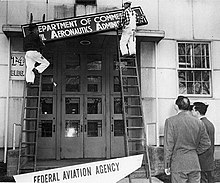Federal Aviation Act of 1958
Dwight Eisenhower on August 23, 1958 | |
| Major amendments | |
|---|---|
| Fly America Act |

The Federal Aviation Act of 1958 was an act of the
.Background
Aviation in the United States was unregulated until the Air Commerce Act became law in 1926.[3] The Act created an Aeronautic Branch within the United States Department of Commerce with regulatory powers over civil aviation. Among the functions the Aeronautic Branch performed were pilot testing and licensing, issuing aircraft airworthiness certificates, establishing and enforcing safety regulations. The agency was also responsible for establishing airways and operating and maintaining aids to air navigation, in addition to investigating accidents and incidents.
In 1934, the Aeronautics Branch was renamed the
In 1938, the Civil Aeronautics Act moved oversight of non-military aviation into a new, independent agency, the Civil Aeronautics Authority.[4] The new agency gained the authority the power to regulate fares and routes for commercial airlines. Another change followed in 1940, with CAA's authority being split. The CAA continued to have authority for air traffic control, safety, and promotion of civil aviation. The new Civil Aeronautics Board (CAB) was established and had responsibility for accident investigation, as well as regulation of safety of civil aviation and pricing of commercial aviation.
A boom in the 1950s of aircraft technology and the airline industry crowded American airspace, and the regulation of air traffic was considered antiquated.[by whom?]
In 1956, President Dwight D. Eisenhower appointed Edward Peck Curtis as Special Assistant for Aviation. Later that year, Curtis was named by Eisenhower to head a commission to study the dramatic increase in airline traffic and to propose ways to deal with airplane traffic jams at airports.[5]
From that commission came a proposal to create a new Federal aviation agency that would replace the Civil Aeronautics Administration and the Civil Aeronautics Board to consolidate air operations, modernize the airways and to make and enforce safety rules.[5]
An ensuing series of plane accidents prompted the creation of the Federal Aviation Agency, later to be known as the Federal Aviation Administration.[2]
Mid-air collisions spur change

On the morning of June 30, 1956,
Two subsequent mid-air collisions between military aircraft and
Citing "recent midair collisions of aircraft occasioning tragic losses of human life," President Eisenhower announced the White House's support of the legislation on June 13. The legislation passed Congress and was signed into law by Eisenhower on August 23, 1958. Eisenhower appointed AMB Chairman Quesada the first FAA Administrator.[2]
A Memorandum of Agreement (MOA) between the DoD and FAA on the Future of Radar Approach Controls in the National Airspace System, 14 December 1988, states that the FAA "determines the standard for NAS equipment and ATC facilities" and that the "DoD will equip facilities providing services to civil users so that the ATC service is transparent to the user."[10]
Codification and repeal
In 1994, Congress approved H.R. 1758 which recodified existing aviation legislation and the 1958 Aviation Act was repealed.[11][12]
See also
References
- ^ Federal Aviation Act, P.L. 85-726, 72 Stat. 731. Approved 1958-08-23.
- ^ a b c d "History". www.faa.gov. Retrieved 2015-06-16.
- ^ Air Commerce Act of 1926, 44 Stat. 568. Approved 1926-05-20.
- ^ Civil Aeronautics Act of 1938, P.L. 75-706, 52 Stat. 973. Approved 1938-06-23.
- ^ a b "Edward P. Curtis, Eisenhower Aviation Aide". The New York Times. March 15, 1987.
- ^ Around Arizona Index. "Grand Canyon Collision." Revised 2007-10-16.
- Aviation Safety Network
- Aviation Safety Network
- ^ "AIR AGE: Epitaph for Disaster". Time. June 2, 1958. Archived from the original on January 31, 2011. Retrieved 2009-11-06.
- ^ U.S. Department of Defense. "Operational Requirements Document II: DoD Air Traffic Control and Landing Systems in the National Airspace System."
- ^ 108 Stat. 745
Further reading
- Rochester, Stuart I. (1976). Takeoff at mid-century : Federal civil aviation policy in the Eisenhower years, 1953-1961. Washington, D.C.: U.S. Dept. of Transportation, Federal Aviation Administration. ASIN B002YNRUXG. babel.hathitrust.org
